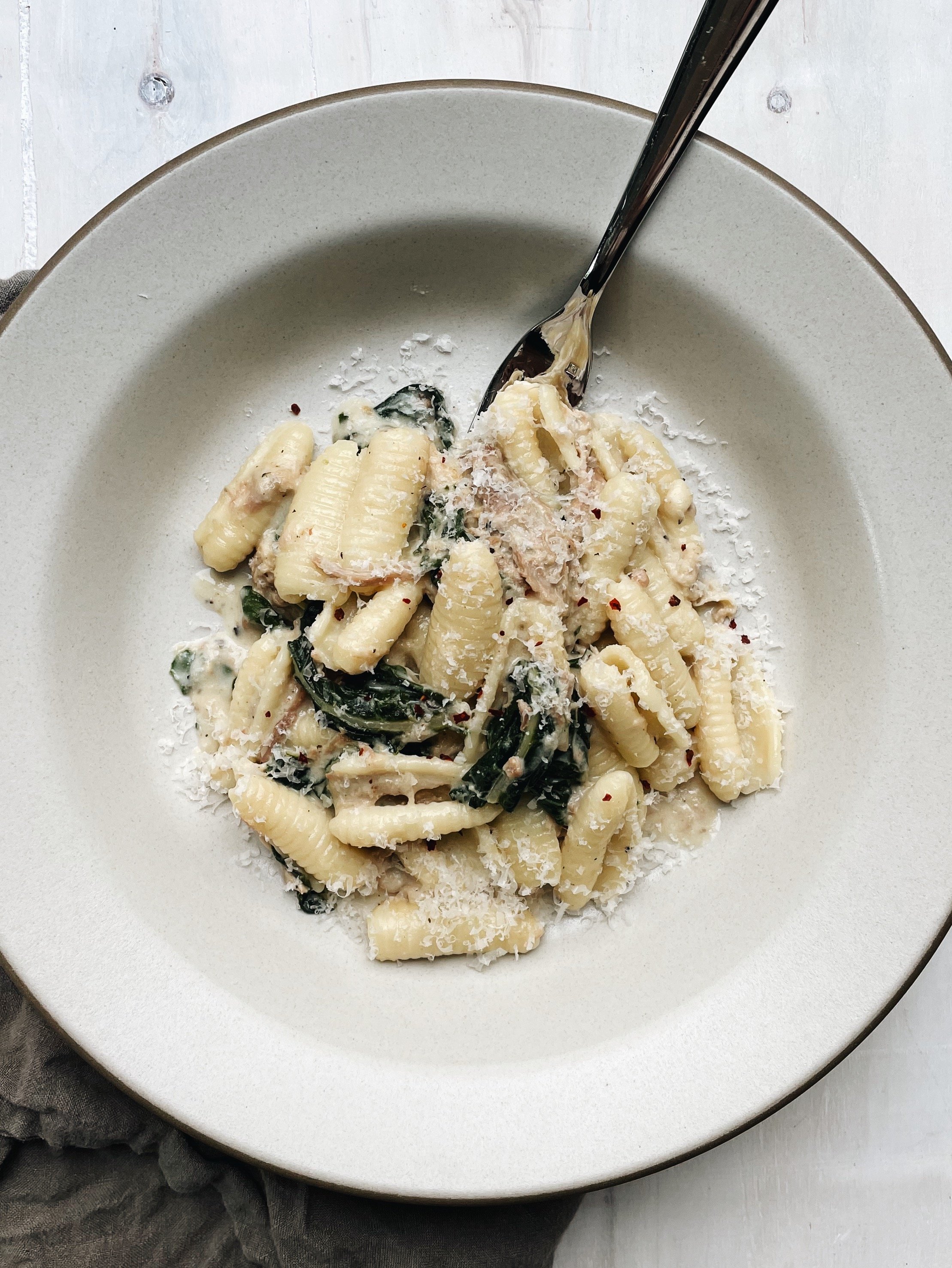milk-braised pork ragù with swiss chard and a lot of garlic
Thanks to my white lamb ragù (which is not really white), a very hands-off sauce with a blended base, I have now opened the gates to the blender-based hands-off white ragù hell. This is my destiny. Now I live to make sauces out of flavorful but texturally unappealing liquids: overcooked vegetables, separated fats, and this time, weird curdled milk bits that are about to become the dreamiest creamy ragù base I promise you have ever seen.
Inspired by traditional maiale al latte—which is pork shoulder just cooked in milk and served as a secondi—this is really stupidly simple as ragùs go. You don’t brown anything, there are no vegetables involved til the end, and the only thing you chop the entire time is a shallot. Besides salt and pepper, the seasonings are just thyme and bay leaves. The trick is the milk, which simmers the pork shoulder into tenderness over several hours and in the process thickens into a really nasty-looking greasy foam that belongs nowhere near pasta. You will think I’ve steered you wrong, and that will be how you know you did it right. This is, unthinkably, what you want.
Like my lamb ragù, this recipe counts on an immersion blender to turn the corner. After removing the meat to shred it, just stick your blender in the pot a few seconds, and suddenly all the sloggy curdles become a silky, rich, creamy sauce base despite no cream in the recipe. However, unlike it’s fraternal twin lamb ragù that requires this step, this one is optional for this recipe. Many people actually enjoy the curds, and say they are the best part. However, I really like the texture better this way, because it feels like more of a sauce and less of a braise. It’s up to you! You can taste it before blending to decide.
Hot pasta is tossed with wilted chard, then the sauce. You will wonder why you never milk braised anything before, how this is yet another thing you’ve wasted time not knowing about until now. You only have two dishes to do, four if you count the plates; the world still sucks, everything is still weird and wrong, but you are still here and now enjoying milk sauce on the last cool night before summer starts and nobody can take that away from you.
RECIPE
Inspired by maiale al latte, or milk-braised pork, this is a hands-off ragù featuring pork shoulder cooked forever in a garlicky milk bath until fall-apart tender; the braising liquid is then blended to a creamy dreamy sauce at the end and tossed with sturdy pasta and wilted chard.
Effortful time: 20 minutes
Total time: 3 1/2-4 hours
Makes enough for 1 1/2 lbs of pasta
YOU NEED
For the ragù
3 1/2-4 lb. pork shoulder roast, remove any butcher twine
8 cloves of garlic, smashed and peeled
2 shallots, roughly chopped
2 tbsp. butter
4 1/2 cups of whole milk
6 sprigs of fresh thyme
2 bay leaves
Salt and pepper, to taste
For serving
A sturdy pasta of your choice, like rigatoni, pappardelle, or mafaldine if you’re feeling fancy
1 bunch chard, leaves stripped and torn or cut into bite sized pieces—how much you use is up to you and how much you like chard, but I budget one small bunch per two people because we really like greens (ps any time you use chard save the stem, chop them up, freeze, and throw em into minestrone verde soup!)
Freshly grated parm and a drizzle of olive oil
Make iT
Do some prep. 20 minutes before you want to start cooking, take your pork and milk out of the fridge. Salt the pork all over and measure the milk; let this come to room temperature. Smash 8 cloves of garlic and mince your shallots.
Create the sauce base. Melt the 2 tbsp of butter in a medium Dutch oven over medium heat. Add the garlic and shallots and cook until fragrant, 30 seconds. Add the milk and bring to a simmer; it will start to curdle, but this is fine. Lower the heat, then put the pork into the milk bath; it won’t be totally submerged. Nestle in the thyme sprigs and bay leaves. Season lightly with salt and pepper. Cover, leaving the lid slightly cracked so the steam can get out.
Simmer the ragù. 1 hour, turn the pork, recover, and repeat for another 1 hour. Then uncover and simmer 1 hour more. At this point, it should be falling apart. It should be, for any reason it isn’t (the heat was different than mine, your pot didn’t conduct heat the same way, your pork piece was larger / tougher/ colder): just keep cooking it! Start early, and you can always keep simmering it til dinner. Remember, this is a low and slow process, and towards the end it reeeeeally feels slow.
Tear or chop your chard. You can do this at any point during the recipe; I did it just before shredding the pork.
Finish the ragù. Using tongs, move the pork to a cutting board. Let this cook a minute, then use two forks to shred all of it into bite sized pieces. Leave this to the side. Now get your stick blender and purée this nasty, curdled disaster sauce into silky, dreamy cream. Adjust for seasoning. Reincorporate all the pork into the sauce and keep over low heat.
Toss a portion of sauce with pasta and chard, then serve. Boil salty water for pasta in a deep skillet. Cook 1-2 minutes under the al dente directions. Save 1 cup or so of pasta water, then drain. In the same skillet, add the pasta, the chard, the servings of sauce you want, and some pasta water, simmering until the pasta is fully cooked and the chard is wilted. Serve each bowl with fresh grated parm and a drizzle of olive oil.


